7 Movie Violence Tropes (That Are BS IRL)

We all know that movies aren't realistic, because no one wants to see a film where Vin Diesel spends four months in rehab after a car crash breaks half the bones in his body. But there are basic elements of these movies that you probably took for truth just because you've seen them over and over, for decades. "Somebody would have checked this at some point, right?"
Not really! Because in real life ...
Sneakily Knocking Someone Out With Chloroform Isn't Actually A Thing

You've all seen the "sneak up behind the victim with a chloroform-soaked rag" bit. It doesn't matter whether the rag gets shoved into the face of a little girl or a tough mercenary -- one whiff of chloroform is enough to instantly, but harmlessly, knock anyone out. Buffy, The Girl Who Kills Vampires, gets chloroformed and goes down like a sack of wooden stakes. It gets played for laughs on Community. In Ace Ventura: Pet Detective, a film otherwise known for its staunch adherence to realism, Jim Carrey takes down a beefy football player in like five seconds:

Meanwhile, In The Real World ...
Chloroform was one of the earliest anesthetics, discovered way back when a doctor's toolkit was disturbingly similar to that of a lumberjack's. But even then, when anesthesia involved a doctor pressing a sponge to his patient's face, they knew the stuff took its sweet time to work. Rendering someone unconscious with chloroform takes two to three minutes. If that doesn't sound like a lot of time, feel free to re-enact any of those famous scenes with a friend ... only this time, you've got to somehow keep that freaking rag pressed to their mouth for 150 seconds or so without them twisting away from it and snatching a breath of air (or yelling for the cops, or elbowing you in the gut, or ... ).
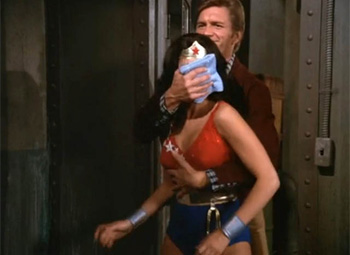
You could go with a dose strong enough to knock them out quicker, but that comes with the side effect of death. That's why anesthesiologists have to carefully take into account a patient's age, gender, weight, overall health, and many other attributes to prescribe a unique chemical cocktail, instead of haphazardly guessing. Everyone has their own unique fine line between going unconscious and shuffling off this mortal coil.
Now, there were records of supposed chloroform-assisted crimes (which likely inspired the pop culture trope), but they actually prove our point. Way back in 1850, in response to a public panic about the new substance being used for crime, John Snow (the one who convinced England that drinking sewer water was a bad idea, not the one who knows nothing) documented real-life cases of chloroform crimes. He found plenty of botched attempts, such as the case of an elderly clergyman who easily overpowered his rag-bearing attackers, and the case of a young woman who ripped a chloroform-soaked handkerchief away from her face and screamed for the police. But he found precisely zero examples of a chloroform-assisted crime actually succeeding.
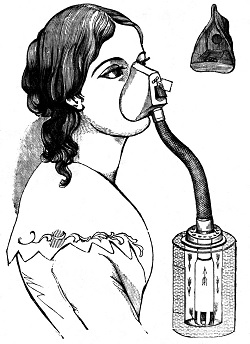
So we've known that chloroform is a useless criminal tool since before the Civil War, but we keep using it in pop culture anyway, because in the universe of movies and TV, the need to quietly knock people unconscious comes up surprisingly often.
Bullets Can Totally Punch Through A Car Door

Any movie with a big police shootout features the cops rolling up, opening their car doors and taking cover behind them, because why not? It's several layers of metal intended to protect you from getting T-boned by a semi, right? Here's The Departed demonstrating that modern automakers construct the body panels of our cars out of solid vibranium:

So keep that in mind if you ever drive into a pitched gun battle -- unless they get the bright idea to aim at your feet, that door will thwart any bad guy who isn't carrying a rocket launcher.
Meanwhile, In The Real World ...
Here's a car door stopping bullets about as effectively as wishful thinking:
MythBusters also took a look at this, and their verdict was the same: Bullets go straight through car doors. Those doors are, above all, designed to be lightweight, and thus use as little metal as possible. Depending on where they hit it, you might just have the thin little panel on the outside, and some foam and plastic on the inside. Here's what one looks like with the inner panel removed:
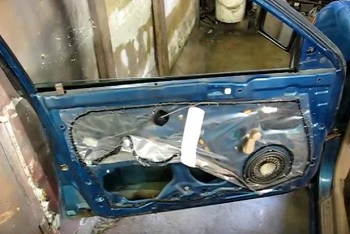
Yeah, that crap is designed to withstand rogue soccer balls and playground-zone speed collisions, not military-grade firepower. If everyday cars were capable of stopping bullets, bulletproofing a vehicle wouldn't be so expensive and laborious. The Pope doesn't exactly roll around in the Popemobile for style, you know?
Landmines Don't Politely Wait Until You Step Off Of Them To Explode

Nothing ramps up the tension quite like having a beloved character step on a landmine. Take this scene from Agents Of S.H.I.E.L.D., where Mrs. Shield (we think that's her name) steps on a mine, which gives off a sporting warning click:

After all, we all know that landmines don't explode when you step on them -- it's when you step off that you get blown into chunks. Now she's rooted to the ground, and she and Mr. Shield have to figure out how to disarm the mine without her stepping off of it. Because that would trigger the explosion, which Hollywood tells us will look like you've just played footsie with a tactical nuke.

Meanwhile, In The Real World ...
Movie landmines work because the moment is too tense for you to stop and consider that they make absolutely no sense. Removing the element of surprise with that audible click (which everyone notices) nullifies the whole point. Unless, for some reason, they built the device specifically to create dramatic tension.
And that's why, with a few devious exceptions, modern landmines are like a teenage boy on prom night, in that they go off the moment they're touched. The likeliest source for the "wait until the weight lifts" trope is the far too erotic-sounding Bouncing Betty, or German S-mine, which were used extensively during World War II because the Nazis couldn't bear the thought of not being awful in even a single category. A soldier would trip one without noticing and then, a couple of steps later, the mine would pop into the air and explode into a horrific shower of shrapnel at around colon height.
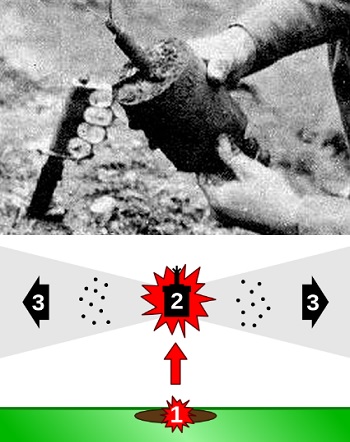
But even then, it wasn't the soldier stepping off the mine that triggered it -- it simply had a delayed fuse. So if you realized that you'd stepped on one and froze in place, all you'd gain is approximately four seconds to bid farewell to a sizeable chunk of your lower body.
If You Need Blood, Don't Slice Open Your Goddamned Palm

You know a problem is serious when a character needs to solve it with their own blood. In Johnny Depp Of The Caribbean, blood is needed to break a curse, so one of the characters who isn't Johnny Depp slices his hand open.
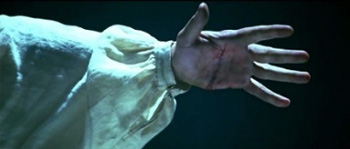
Human blood is also handy for monster fighting. In The Thing, the survivors of the shapeshifting alien's rampage draw blood as a test of their humanity. And in Stranger Things, blood is used to purposely lure out the monster. In both cases, they accomplish this by chopping their hands open. How else would you do it?
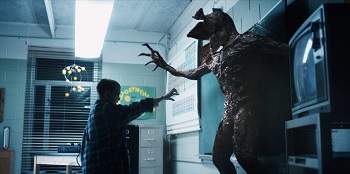
Meanwhile, In The Real World ...
Pretty much any other part of your body, short of your genitals or eyeballs, would be better to get blood from. Forearm, bicep, ankle ...
We mean, have you ever had a cut on your palm or fingers? If so, you'll know that even a moderate one can do enough damage to make simple tasks a frustrating slog. It's tough to properly grab things, cooking food is literally just rubbing salt in the wound, and good luck doing effective physical labor.
So why would someone who is in the middle of a fight for their life and who needs to be able to use weapons, willingly stab their own palm? Whether you're about to need to wield a pirate sword, pistol or an ax, you're doing it with a hand that is now slick with blood and blazing with pain. And that wound is going to reopen every time you do anything.
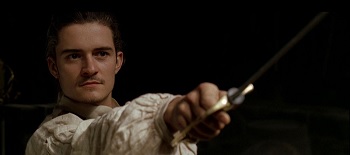
It's like Hollywood decided this was the one badass way to draw blood, and everyone was sticking with it. That pirate curse didn't care how much blood there was, or where it came from. It's the same situation in The Thing -- a few drops from literally anywhere would have been sufficient, but instead they grab scalpels and go to town.
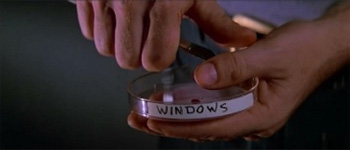
Ditto Stranger Things. It's been established that a mere drop or two is more than enough to attract the monster, so of course they both proceed to cut open the very hands they intend to use to fight the monster when it arrives.
Keep in mind that, depending on the depth of the cut, a wound longer than two centimeters is likely to need some medical attention. Good luck getting that while stuck in a doctor-less frozen wasteland with a killer shapeshifter on the loose and a lot fewer functioning thumbs than you started out with, cast of The Thing!
Leaving Your Head Exposed Will Get You Killed -- One Way Or The Other

Picture Jon Snow with a hat on. You can't, can you? That's because he's never worn one, even when spending the night on top of an unsheltered windy mountain that makes the mid-December Alaskan wilderness look like sandal weather.
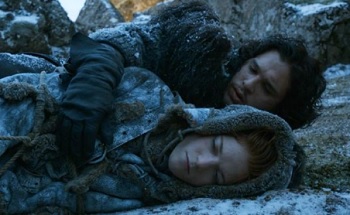
Heroes don't just ignore common sense when it comes to weather, either. Can you spot the main characters in these battles?

They are, of course, the ones without the protective headwear. Because who needs it, when you have plot armor?
Meanwhile, In The Real World ...
Let's start with the part every kid with a mom knows by age five: Frostbite is a thing, and it doesn't even require arctic conditions -- just prolonged exposure to cold. You know, like your average man of the Night's Watch experiences daily.
In cold temperatures, your extremities are most likely to freeze, because your body works to preserve the heat in your core, where your heart, lungs, and other bits that keep you alive tend to be located. Your nose, your ears, your fingers and toes ... they all lose blood flow, and it's up to you to keep them warm with insulating clothing. Jon's fabulous curls wouldn't have saved him -- his ears would have been gone by the end of the third episode.

To be fair, Jon is only following local fashion. You'll spot a few Wildlings wearing hoods or hats, but characters with lines seem to fear headgear. They don't even bother with earmuffs when they spend hours climbing the giant ice wall in stormy weather. That plot should have ended with a farmer stumbling across a pile of sawed-off gangrenous limbs.

And then there's the even more obvious benefit of helmets in a battle. We're not even talking about getting shot or stabbed in the skull -- we're talking about banging your head into anything. You know that feeling when you bump your head against a kitchen cabinet? That full minute of clutching your scalp and cursing, because there's nothing else you're capable of doing until the pain goes away? Imagine that, only you're surrounded by people who are frantically trying to kill you. We get that Tormund up there is supposed to be so acclimated to the cold that he needs only his manly beard to keep him warm, but will it prevent a 50-pound hunk of falling ice from cracking open his cranium like an egg?
We realize the benefits of brain protection isn't new information to many of you -- we just think it's hilarious to point out how passionate the hair and makeup department are about making sure their work remains on glorious display at all times.

No, You Don't Test Drugs By Tasting Them

Whenever a cop finds an unknown white powder, they need to taste it to determine what it is, like in this shot from Castle, that crime drama starring Malcolm Reynolds.
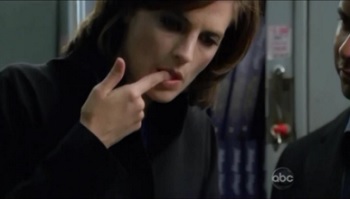
The cops in Goodfellas do it too, dipping into the powder they confiscate from the mobsters like it's the spoils of Halloween.
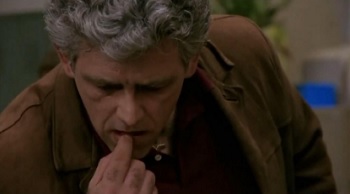
"OK, calm down--"
"I CAN'T!"
You may also have seen this in pretty much every 1980s movie involving a vice cop. If they're really cool, they'll do the tasting with their gun hand, like Lt. Tango here:

It makes sense, right? They want to immediately get a sense of what kind of crime they're dealing with, or if there's even a crime at all -- maybe someone just spilled a packet of Sweet'N Low.
Meanwhile, In The Real World ...
Even you, who we're going to assume isn't too involved in the drug trade, has a sense of what most drugs look like, so a career cop who raids drug dens as often as we raid the nearest taco truck knows exactly what heroin looks and tastes like. It's like this, right?

Or maybe something like this?
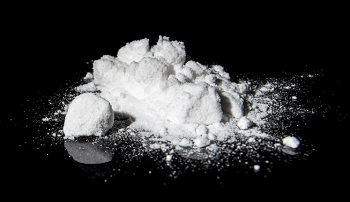
It's so visually distinctive from cocaine, isn't it?
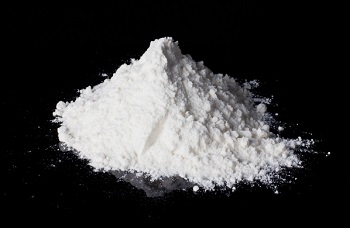
And from cyanide?
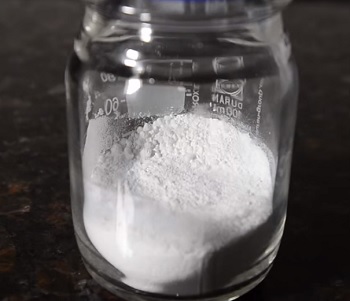
Yeah, taste even a couple grains of that basically identical powder, and you're dead. Oh, and one of those pictures was just baking powder. Feel free to tell us which, if you can, because we've already gotten them confused. But our point is that "don't put unknown substances in your mouth" is a lesson that gets drilled into us from the moment we're capable of understanding phrases like "get away from the toilet." We're betting the only reason real police even need to be trained not to do this is because of all those movies.
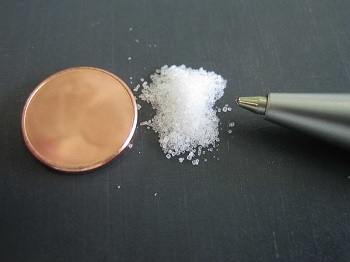
In real life, they take unknown substances seriously, which helps explain the existence of forensic labs where they employ scientific methods beyond the "I wonder how this goes with the ham sandwich I just ate?" test.
Police Raids Just Don't Look Like That

You can all picture a police raid on a violent gang's hideout, right? A group of heavily armed cops bash in the door, stream in, and shove their guns right into everyone's faces, just in case some of the criminals are severely myopic. Just like in this raid from The Fast And The Furious: Whichever One This Is:
Often, the police will announce their presence well in advance. In Straight Outta Compton, they put on their sirens and speed down the street in the middle of the night in a small tank, giving Eazy-E plenty of time to escape and form a rap group. The same thing happens in Layer Cake, otherwise known as James Bond Gets Sick Of Bonding And Becomes A Classy Drug Dealer. The police are loud, aggressive, and seen from a mile away, turning the raid into a dramatic chase.
Once they're inside, they usually stab their way into dim rooms with their guns extended as far in front of them as possible ...
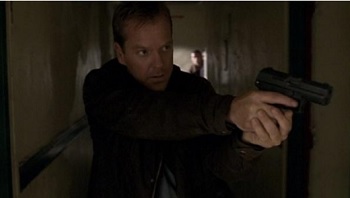
... making an inviting target for that one bad guy who will inevitably jump out of the closet and grab for their weapon. You have to give the bad guys some kind of a chance, right? It's in the Constitution.
Meanwhile, In The Real World ...
In the law enforcement biz, there's actually a term for going in gun-first: flagging. It means prematurely announcing your presence by shoving your gun barrel (or any part of your body) into a room where everyone inside the crack house can see it. If you watch actual police approaching a doorway (hopefully not yours), you'll notice they keep the gun close to the body, specifically to avoid the close quarters gun-fu you've seen play out in a hundred action movies:
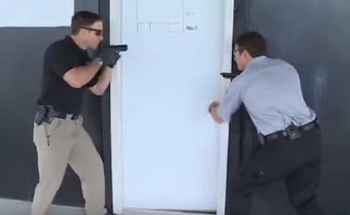
Then, they proceed to stay outside the room until they've had a chance to make an arc around the outside, peering in at every available angle to see as many corners as possible before charging in. And even then, there's no running straight up to a suspect to shout them into submission. Teams will stay close to the walls and gradually close in. The idea is that everyone can see the remaining hidden corners simultaneously, since bad guys have been hiding in corners literally since the invention of square rooms.
And, obviously, you don't want to loudly announce your presence ahead of time. This is due to the fundamental, yet often unnoticed, difference between Hollywood police work and the real thing: In the case of the latter, a quiet, uneventful, straightforward arrest is the whole point. If the situation devolves into chaos -- even if it involves badass spin-kicks and dudes jumping through plate glass -- somebody has screwed up.
Loose cannons see unemployment by day two, no matter how entertaining they are.
Good police work shouldn't look like an action movie, for the same reason you don't want your colonoscopy to look like a direct-to-video Rob Schneider comedy where he plays a doctor. Or a horror movie. Or a fetish porno. You don't want that to look like any kind of movie, really.
For more ways Hollywood is bullshitting us, check out 23 Lies Everyone Believes About Violence (Thanks to Movies) and 20 Lies You Believe Thanks to 'Realistic' Movies and TV Show.
Subscribe to our YouTube channel, and check out Why Star Trek Technology Would Destroy Us, and other videos you won't see on the site!
Also, follow us on Facebook, and we'll follow you everywhere.